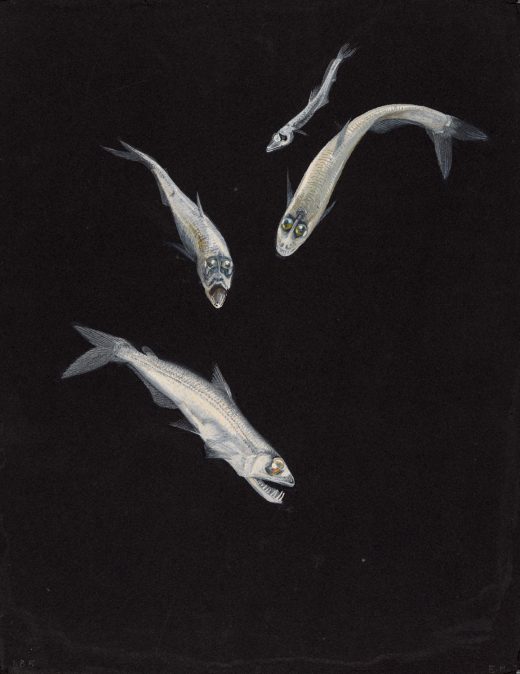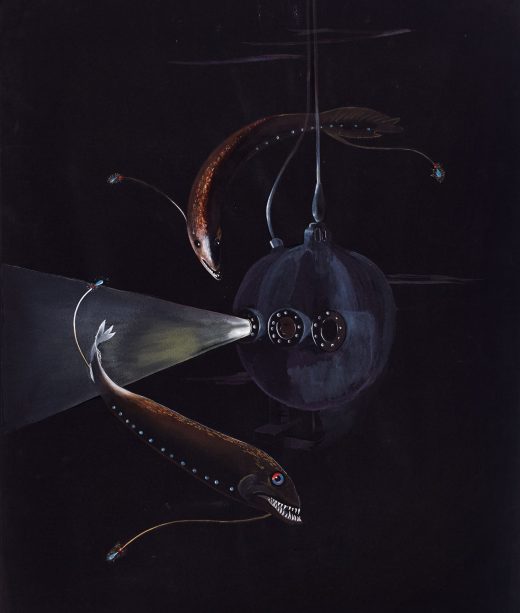Drawing the Deep Sea from a Seat on the Shore
In the 1930s, artist Else Bostelmann illuminated in art what scientist William Beebe dictated to her from his cramped seat in a spherical steel bathysphere as it explored the deep sea off Bermuda. She also set up an underwater studio.
Article body copy
1200 [feet] Idiacanthus. Two Astronesthes.
1250 Fish 5-inch-long, shaped like Stomias
3-inch shrimps absolutely white.
Argyropelecus in light beam.
2 luminous pale white jellies.
1300 6 or 8 shrimps.
50 or 100 lights like fireflies.
Small squid in beam of light,
seems to have no lights, went down to bait.
Cyclothones. Two-inch shrimps.
1350 Light very pale.
Temp. 72 [°F]. Meter wheel reading 403.
1400 Looking straight down very black.
Black as hell.
These observations were dictated by William Beebe, ornithologist, marine biologist, co-inventor of the bathysphere—a spherical steel submersible with just enough space for two skinny men. It was 1930, off the coast of Bermuda, and two skinny men—Beebe and engineer Otis Barton—were engaged in a record-breaking expedition observing life of the deep sea in situ. For each of their dives, Beebe would narrate his observations via a cable that connected the bathysphere to an assistant, most often Gloria Hollister, on the research barge above.
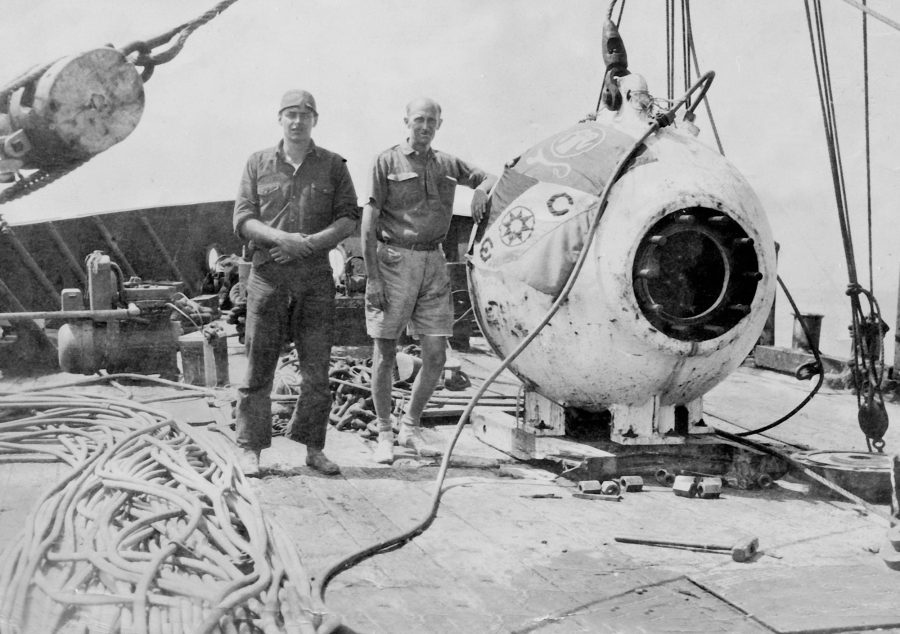 Researchers Otis Barton and William Beebe with their submersible bathysphere in 1934. Photo by Sueddeutsche Zeitung Photo/Alamy Stock Photo
Researchers Otis Barton and William Beebe with their submersible bathysphere in 1934. Photo by Sueddeutsche Zeitung Photo/Alamy Stock Photo
Words alone, though, fell short of conveying the fantastical creatures Beebe saw. Artist Else Bostelmann added color and form to Beebe’s observations—she drew what he saw, only occasionally ever seeing the animal herself when a trawl brought samples to the surface. Where photographs and words failed, Bostelmann brought to life the wonders of the deep in hundreds of prints, including stunning “black paintings” of deep-sea life rendered on black backgrounds.
In The Bathysphere Book: Effects of the Luminous Ocean Depths, writer Brad Fox tells the story of the bathysphere, its passengers, and those in the orbit of the remarkable undersea endeavor. In this excerpt, we meet Bostelmann and journey with her as she enters the realm she painted so often—not quite to the deeps in the bathysphere but instead to the shallows with a hulking copper diving helmet pressing down on her shoulders. And it was here the innovative and wildly talented artist devised a way to paint underwater.
Several miles off Gurnet’s Rock, dressed in a bright-red swimsuit, her cropped curls tinged with gray, Else Bostelmann swung a leg onto a metal ladder that dropped 12 meters below the ocean’s surface.
She had just returned to work a few years ago. She’d won prizes at art school in [the Grand Ducal Academy in] Weimar, Germany, but then had come to America, married a man named Monroe, and abandoned her career. Only when Monroe dropped dead 11 years later did she pick her brushes back up. She was skilled—she had a vivid and accurate style, adept at catching details of the natural world. A few small assignments attracted some attention before Beebe hired her for the Bermuda expedition.
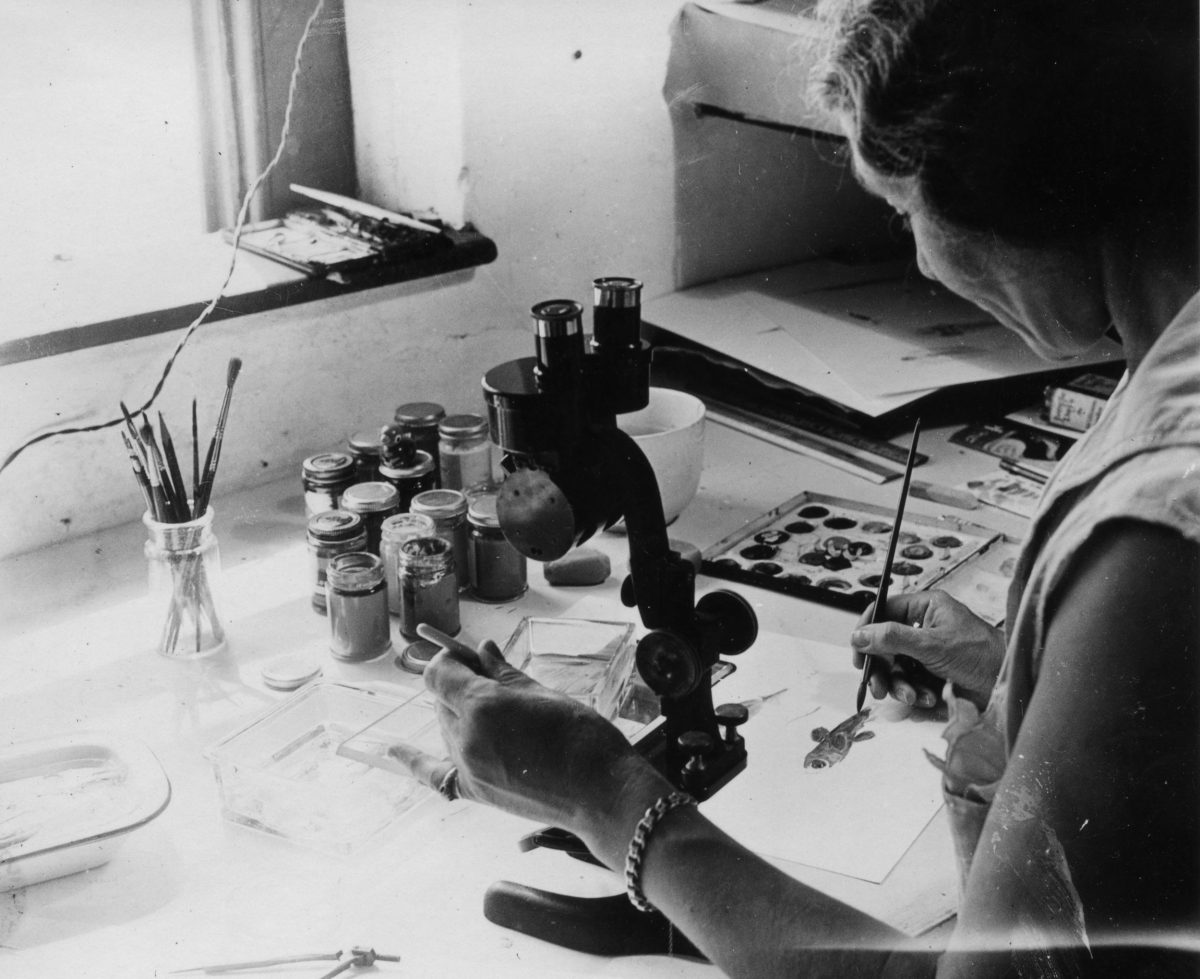
Artist Else Bostelmann was a staff member with the Wildlife Conservation Society’s Department of Tropical Research. Although she painted the creatures that Beebe and Barton saw through the bathysphere window, she also painted species that were brought to the surface, often working quickly before their colors faded. Photo courtesy of Wildlife Conservation Society
With Barton’s photographs useless, Beebe relied on staff artists to depict creatures he saw in the deep. This was scientific proof, evidence of new species. There was no room for inaccuracy.
He worked with Helen Damrosch Tee-Van, who married his assistant, John. But in Bostelmann he found a true collaborator. Like a police sketch artist, she had a talent for painting creatures she hadn’t seen, based just off Beebe’s words. While Beebe and Hollister completed specimen cards with detailed descriptions, Bostelmann rendered images, checking and altering until she got them right. Sea devils and anglerfish, outlandish creatures that moments before she hadn’t known existed.
Two examples of Bostelmann’s black paintings from the 1930s-era bathysphere expeditions off Bermuda: a species of deep-sea fish, first, and a saber-toothed viperfish, second. Images courtesy of Wildlife Conservation Society
Now she scrambled down to the water and waited while Beebe placed a bulky copper diving helmet over her head so it rested on her shoulders. She grabbed onto the ladder with her right hand, and with her left clutched a zinc engraver’s plate and steel pin.
Standing on the ladder, still at the side of the launch, she could feel the flow of fresh air into the helmet from the pump on board the launch. Breathing naturally, she let herself down into the water, and as she sank, the 27-kilogram helmet felt surprisingly light on her shoulders.
Looking down through the glass window of the helmet, a landscape of bright corals and multicolored underwater plant life emerged, more glorious than anything on land. She descended the iron rungs of the ladder 11 meters, then dropped onto the white sand of the seafloor, fine and soft as any sand she knew. Above her, sunbeams struck the ocean’s surface and split into rays lighting up the water like dust in a dark room, brightly luminous but cool, all greens and splintered yellows and a blue that was somehow brighter than daylight. The brilliance around her faded quickly to darkness as she gazed into the near distance.
As if the water swallows the colors and the light, she thought.
Bostelmann’s black paintings of the bathysphere with fishes, titled Giants of the Deep, first; and three views of constellation fish, second. Images courtesy of Wildlife Conservation Society
There was constant movement within the complex architecture of the reef—squirrelfish and anemones and other creatures lurking and swimming and grabbing at food. The blunt yellow beaks of parrotfish appeared and disappeared from view, and jellyfish that reminded her of butterflies. She reached out to grab a piece of coral but came up empty-handed. The water obscured distance, so things were farther away than they appeared. She took a step forward and reached out again only to draw back her hand quickly as the venomous coral burned her fingertips.
She stood still for a second trying to gain a sense of where she was, then jumped as she felt itches and stings everywhere. She turned her heavy-laden head as fast as she could and saw a cloud of tiny fish taking small sharp bites at her arms and legs. Reassured they were not dangerous, the bites became ticklish and hilarious.
She gained her bearing on the seafloor and once again looked up to see several objects looming above her: an iron music stand, as light as a feather underwater, and a shallow metal tub. She reached up to grab them as they fell and guided them to the white sand at her feet. A bundle of paintbrushes attached to the tub stood on end due to the buoyancy of their wooden handles.
Soon a stretched canvas appeared, and she affixed it with tacks to the music stand.
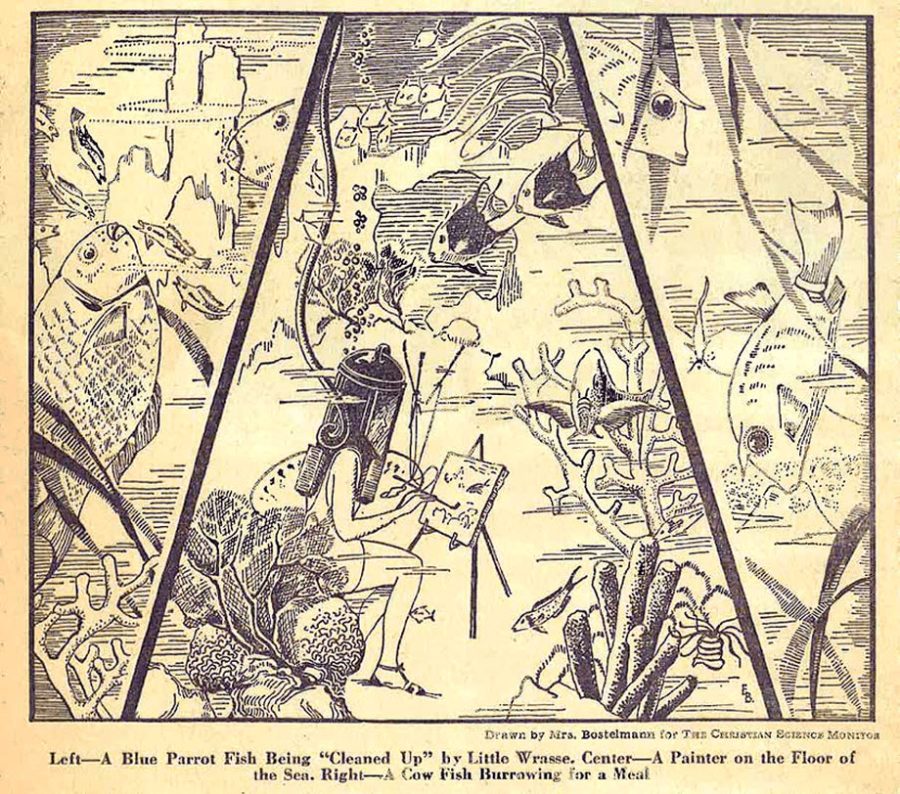
Bostelmann created this pen-and-ink illustration for a 1935 article in the Christian Science Monitor. The illustration and article describe how she painted underwater. Image via ReseachGate/Creative Commons
Now she just had to get into position. She took a step and it felt like she was moving through glue. She leaned forward as if into a headwind and dragged her gear several feet from the reef. Finally, she got everything in place and was ready to get to work. She eyed the reef, mentally composing the canvas, then grabbed one of the upward-pointing brushes by its wooden handle and knelt to dab it with blue oil paint. But again, misreading the distance, she stuck it into the green instead.
Oh well, she thought, and dabbed the green on the canvas to outline the form of the reef. But when she turned back to her tub full of paint, it was gone. Swinging around she saw it drifting away in the undersea current, its globs of color mixing into the landscape. She glanced back at her music stand, which she had weighted to the sea floor, then squatted awkwardly, moving on her hands and knees after the tub while struggling to keep her head up so the helmet wouldn’t fall off.
In a few minutes, she wrestled the tub back into place. The fresh air still filled her helmet, and she was able to catch her breath before grabbing a vertical brush and kneeling to dab it into the right color.
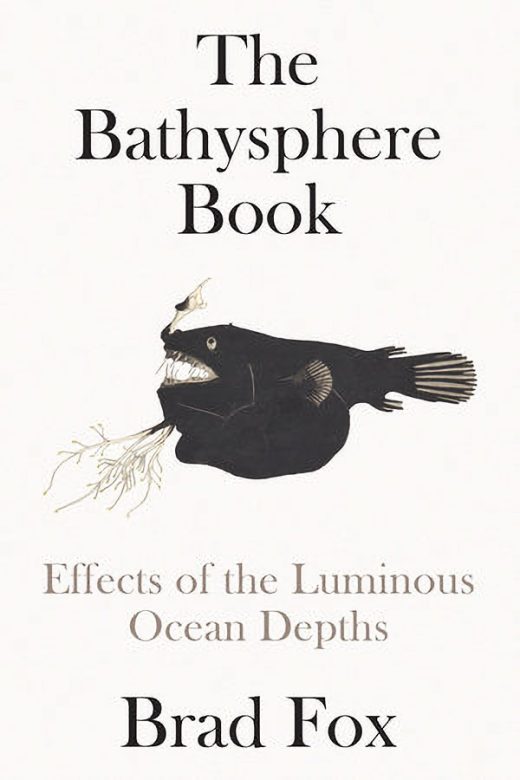 Adapted from The Bathysphere Book: Effects of the Luminous Ocean Depths, by Brad Fox. Copyright© 2023 by Brad Fox. Used with permission of the publisher, Astra House. All rights reserved.
Adapted from The Bathysphere Book: Effects of the Luminous Ocean Depths, by Brad Fox. Copyright© 2023 by Brad Fox. Used with permission of the publisher, Astra House. All rights reserved.


